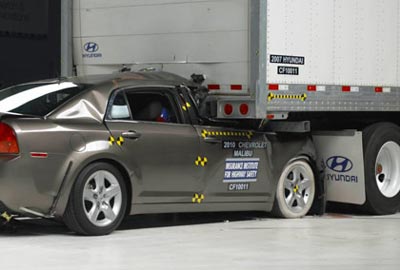
| Monday, March 07, 2011 | Archives | Advertise | Online Buyer's Guide | FLEETSolutions |
IIHS Testing Shows Underride Guards On Big Rigs Often Fail In Crashes
 New crash tests and analysis by the Insurance Institute for Highway Safety (IIHS) demonstrate that underride guards on tractor-trailers can fail in relatively low-speed crashes – with deadly consequences. The Institute is petitioning the federal government to require stronger underride guards that will remain in place during a crash and to mandate guards for more large trucks and trailers. Rear guards are the main countermeasure for reducing underride deaths and injuries when a passenger vehicle crashes into the back of a tractor-trailer. In 2009, 70 percent of the 3,163 people who died in all large truck crashes were occupants of cars or other passenger vehicles. Underride makes death or serious injury more likely since the upper part of the passenger vehicle's occupant compartment typically crushes as the truck body intrudes into the vehicle safety cage. "Cars' front-end structures are designed to manage a tremendous amount of crash energy in a way that minimizes injuries for their occupants," says Adrian Lund, Institute President. "Hitting the back of a large truck is a game changer. You might be riding in a vehicle that earns top marks in frontal crash tests, but if the truck's underride guard fails — or isn't there at all — your chances of walking away from even a relatively low-speed crash aren't good. Institute side impact crash test: The Institute has studied the underride crash problem for more than 30 years, including mid-1970s crash tests demonstrating how then-current guards were ineffective in preventing underride. In the latest study the Institute analyzed case files from the Large Truck Crash Causation Study, a federal database of roughly 1,000 real-world crashes in 2001-03, to identify crash patterns leading to rear underride of heavy trucks and semi-trailers with and without guards. Underride was a common outcome of the 115 crashes involving a passenger vehicle striking the back of a heavy truck or semi-trailer. Only 22 percent of the crashes didn't involve underride or had only negligible underride, a finding in line with prior studies. In 23 of the 28 cases in which someone in the passenger vehicle died, there was severe or catastrophic underride damage, meaning the entire front end or more of the vehicle slid beneath the truck. The National Highway Traffic Safety Administration (NHTSA) has estimated that about 423 people in passenger vehicles die each year when their vehicles strike the backs of large trucks. More than 5,000 passenger vehicle occupants are injured. |
 |
NAFA Fleet Management Association 125 Village Blvd., Suite 200 Princeton, NJ 08540 Telephone: 609.720.0882 Fax: 609.452.8004 |





